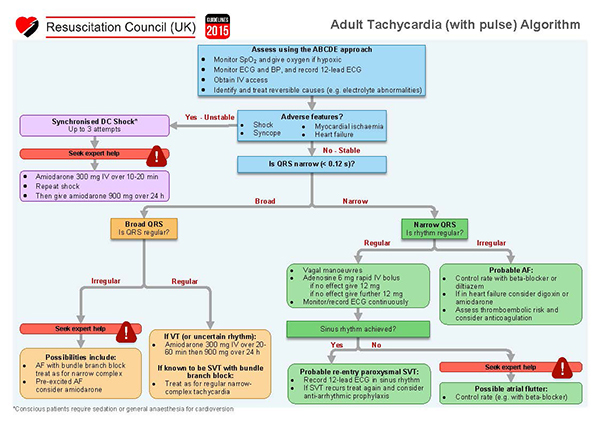- Tachycardia is defined as a heart rate greater than 100 beats per minute (BMJ best practice).
- If possible, ascertain if patient has:
- Previous admissions with chest pain or cardiac conditions
- Been diagnosed with a cardiac condition
- Been taking medication for a cardiac condition
- Had any operations on their heart
- Any allergies
- Shortness of breath (dyspnoea)
- Cyanosis
- Chest pain
- Palpitations
- Cool peripheries
- Fatigue
- Dizziness
- Reduced exercise tolerance
- Collapse
- Tachypnoea
- Tachycardia
- Hypotension
- Narrow complex tachycardia
- Defined as QRS complex < 0.12 s
- This suggests that depolarisation passes from the atrioventricular node to the Bundle of His and Purkinje fibres leading to ventricular depolarisation
- Establish if the rhythm is:
- Irregular
- Atrial fibrillation
- Regular
- Supraventricular tachycardia (SVT)
- Junctional tachycardia
- Some re-entrant rhythms
- Irregular
- Broad complex tachycardia
- QRS complex > 0.12 s
- This suggests that depolarisation of the ventricles occurs through an abnormal mechanism, e.g. through an accessory pathway or automaticity within the ventricles
- Establish if the rhythm is:
- Regular
- Monomorphic ventricular tachycardia
- SVT with aberrant conduction
- Some re-entrant rhythms
- Irregular
- Polymorphic ventricular tachycardia
- Regular
- ABCDE assessment
- Assess patient’s airway
- Monitor oxygen saturations and respiratory rate
- If patient is hypoxic give Oxygen (O2) to achieve target saturations. Initially give 15 L/min via a reservoir mask if the patient is acutely unwell
- Target saturations:
- 94 - 98% for patients not at risk of hypercapnic respiratory failure
- 88 - 92% for patients at risk of hypercapnic respiratory failure due to conditions such as Chronic Obstructive Pulmonary Disease (COPD)
- Arterial blood gas (ABG) if concerned about patient’s ventilation
- Examine patient’s chest
- Listening for:
- Bibasal crepitations
- Cardiac wheeze
- Listening for:
- Chest X-ray if concerned about patient’s ventilation. If the patient is unwell request a portable X-ray
- Obtain intravenous access by placing 2 large bore cannulae in the antecubital fossa. Take blood to check Full Blood Count (FBC), Urea and Electrolytes (U&Es), Liver Function Tests (LFTS), Calcium, Glucose, Magnesium and Venous Blood Gas (VBG)
- Check Capillary Refill Time (CRT) - hold for five seconds and refilling should occur in 3 seconds
- Assess pulse rate, rhythm and character
- If no pulse present start advanced life support
- Monitor heart rate and blood pressure
- Listen to patient’s heart sounds
- 12 lead Electrocardiogram (ECG)
- Call for senior help
- Attach patient to cardiac monitor
- Consider sepsis six if sepsis suspected. For further information see “Sepsis” Section in “Medical Emergencies” Chapter
- Identify underlying cause and treat
- Identify adverse features: -
- Shock
- Syncope
- Myocardial ischaemia
- Heart failure
- Check patient’s urine output and consider catheterisation
- Call for help if not already done
- Check pupils are equal and reactive
- Assess Glasgow Coma Scale or ACVPU using the NEWS2 chart
- Check patient’s temperature and blood sugar
- Examine patient’s abdomen and legs
- Consider venous thromboembolism prophylaxis
Response
- Follow RESUS guidelines

Tachycardia algorithm
- Discuss with senior member of the team
- Contact critical care outreach team
- Referral to cardiologists
- Referral to anaesthetists if cardioversion is required
- Consider referral to Intensive Care Unit (ICU) if:
- Failure to respond to medical management
- Patient requires ventilator support
- Patient requires blood pressure support
- Deterioration of blood gas following medical management
- Review by cardiologists regarding future management
- Medical
- Surgical ablation of accessory pathway